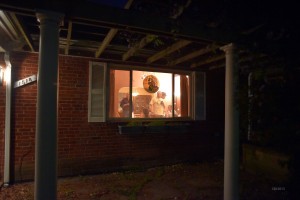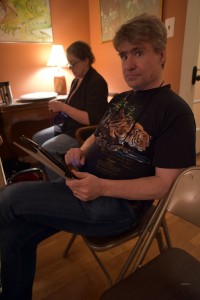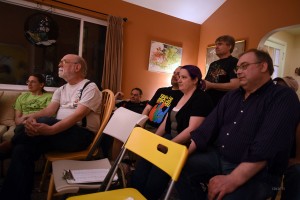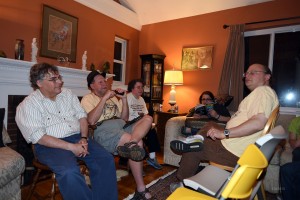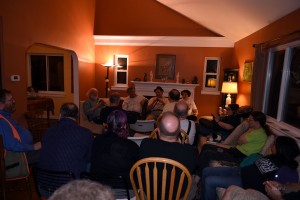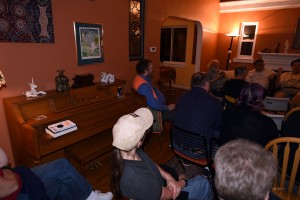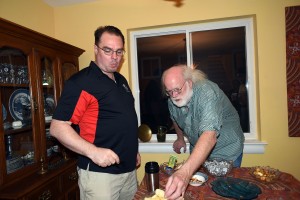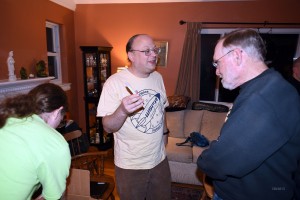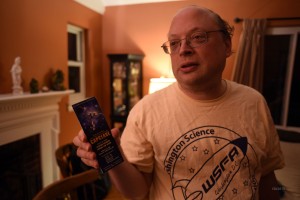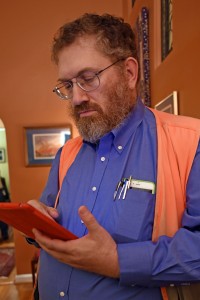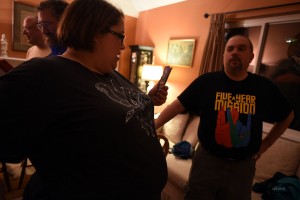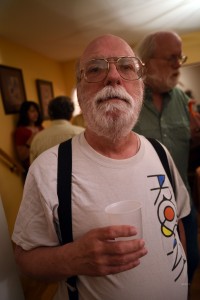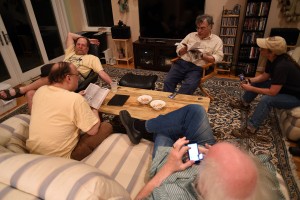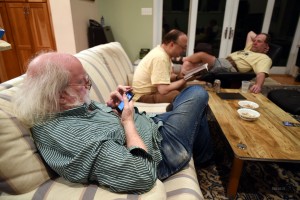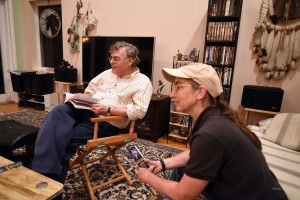Depth by Lev AC Rosen
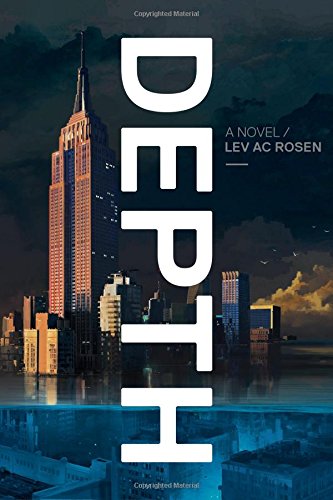 Depth by Lev AC Rosen
Depth by Lev AC Rosen
Review by Ernest Lilley
Regan Arts. Hardcover ISBN/ITEM#: 1941393071
Date: 28 April 2015 List Price $24.95 Amazon US /
Simone Pierce is a gumshoe in galoshes in a post-climate-change New York City that isn’t so much Venice as it is Atlantis just before it slips beneath the waves. The water stopped rising at the 21st floor, and the big apple is now bobbing in the Atlantic, miles from shore. Aside from that, Depth is a pretty straightforward clone of the Hollywood PI story. Simone is supposed to be trailing a cheating husband, but the blonde in the picture, and it’s always a blonde, doesn’t look like that’s what she’s selling. Then our gal picks up another case, babysitting a guy looking for the fabled lost tunnel beneath the waves and she has to juggle her cases to keep everything afloat. Oh, you winced at the “afloat” bit. That’s nothing compared to the nautical jargon that the author has injected for slang, skipper.
As it always happens in detective stories, everybody winds up involved in the same con in one way or another, and they’re all lying to you. Either that or they’re lying to themselves.
Frankly, I like my noir detectives gritty and world-weary, and you’d think being a New York City PI after an apocalyptic sea-level rise would provide enough water-logging to sink a Shamus’ spirits. Not so. Our gal is just a standard career detective who passed on a job on the force like her dad, who got into the PI biz the traditional way, and now she takes cases from her best gal-pal, the deputy mayor. She’s got an ex-boyfriend on the force, but lipstick is thicker than water if you ask me, and Simone’s only really crisis comes when she can’t figure out if her best friend is her friend at all. Can gals have a bro-mance? Ironically, in today’s literary market, “strong women,” are the normalized characters. Were that not the case, I expect that his protagonists would just have been gay and been done with it.
If the characters grabbed me, nothing else would matter, but they didn’t, so my attention turned to the scenery. I know it’s petty of me, but the whole sea-level rise thing is just badly done. Three hundred years on, the waters have risen to the 21st floor in NYC and the entire eastern seaboard is underwater all the way to Chicago. Seriously, you have to ask if the author has been to New York (he has, he lives there). For one thing, it’s not flat, and what may be the 21st floor in the Battery is somewhere in the sub-sub basement on the Upper East Side. Not to mention the Palisades. Or what tides would do to all the lobbies that our gal wades her way through.
If he’d bothered to check the map he could have come up with a much more interesting landscape.(1) If he wants to go back to this waterlogged world again, and there’s no reason he shouldn’t, I recommend he read Paolo Bacigalupi’s The Windup Girl or The Drowned Cities to see how it’s done.
I expect this book will find a fairly receptive audience, and that’s fine, but I wanted a lot more but it never wound up delivering it. The writing is fairly good, but I never really connected with the main character. Like any noir PI tale, the plot is twisty and the bad guys are always closer to you than you’d like. Really, all it needs is a little more depth.
Links / References
(1) 21 stories is about 250 ft, or 75 m. You can get an idea of what that means at: Geology.com: New York City, Long Island and Newark – Sea Level Rise Map; http://geology.com/sea-level-rise/new-york.shtml
Daryl Gregory on Afterparty, We Are All Completely Fine, and Harrison Squared
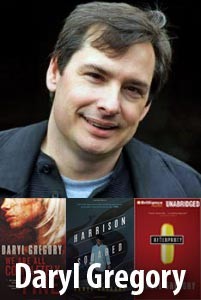 Daryl Gregory has been cranking out some terrific fiction. He first popped onto our radar with last year’s Afterparty, then again with the Nebula Award nomination(1) for his Novella: We Are All Completely Fine, which meant we had to read the prequel novel, Harrison Squared, that came out this March. And then, we had some questions. Fortunately, he had time to find us some answers.
Daryl Gregory has been cranking out some terrific fiction. He first popped onto our radar with last year’s Afterparty, then again with the Nebula Award nomination(1) for his Novella: We Are All Completely Fine, which meant we had to read the prequel novel, Harrison Squared, that came out this March. And then, we had some questions. Fortunately, he had time to find us some answers.
SFRevu: Your novella, We Are All Completely Fine, came out in August 2014 from Tachyon, but Harrison Squared, its prequel, or first of its prequels, just came out in late March 2015 from Tor. Now, that doesn’t seem like quite enough time to have written WAACF, then decide to write a novel to set it up, so how did that happen, anyway?
Daryl Gregory: It happened in the most complicated way possible. I wrote the first draft of Harrison Squared as a middle-grade adventure novel, intending to write something light and fun with as much banter as possible. My idea of light and fun, however, was out of step with middle grade editors. Several of them said that what I’d written was way too scary for little kids. (I don’t think this is true. I loved gruesome stuff when I was ten. But hey, that’s the market.)
I was ready to set aside the book as an experiment, but it did start me thinking about what kind of PTSD a grown-up Harrison would have to cope with. And what about all those sole survivors of horror novels and movies? Surely they needed a lot of therapy. Jacob Weisman of Tachyon had been after to me to write a novella for him, so I pitched him the idea of a therapy group made up of final girls and last men standing. He thought it was a hilarious idea. I kept trying to explain that it wasn’t funny. We still argue about whether the novella is a comedy. I think we’ve compromised on “ultra-dark comedy.”
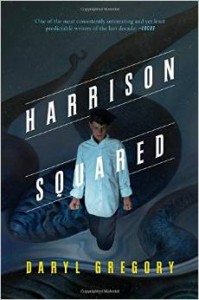 While I was writing the novella, Tor offered to buy Harrison Squared, but they were interested in YA, not middle grade, and asked if I’d be willing to change it. I said, if you’re willing to pay me, I’m interested. But this actually solved my scariness problem for me. An older protagonist, and therefore older readers, would be able to handle the creepy stuff, and allow me to spend more time with the monsters, which is always my favorite part of horror stories.
While I was writing the novella, Tor offered to buy Harrison Squared, but they were interested in YA, not middle grade, and asked if I’d be willing to change it. I said, if you’re willing to pay me, I’m interested. But this actually solved my scariness problem for me. An older protagonist, and therefore older readers, would be able to handle the creepy stuff, and allow me to spend more time with the monsters, which is always my favorite part of horror stories.
So, as soon as I finished WAACF, I rewrote Harrison Squared from scratch, using that first draft as a kind of detailed outline that was missing some of the story. But because I now had written the adult Harrison, that changed how I wrote him as a kid. There’s still a big gap between the boy he was and the man he becomes—but now I know what that arc is.
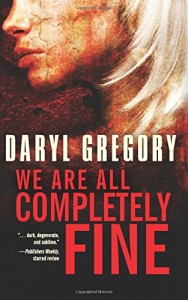 SFRevu: The setting in WAACF is a therapy group for survivors of supernatural horror, though at the outset its members don’t know that they’re connected. You did an excellent job of capturing the personalities and tensions crop up in therapy. How much of yourself are you channeling here? Which is probably just beating around the bush to ask if you’re as pissed off as Harrison. It’s OK. This is a safe space and nobody’s judging. Mostly.
SFRevu: The setting in WAACF is a therapy group for survivors of supernatural horror, though at the outset its members don’t know that they’re connected. You did an excellent job of capturing the personalities and tensions crop up in therapy. How much of yourself are you channeling here? Which is probably just beating around the bush to ask if you’re as pissed off as Harrison. It’s OK. This is a safe space and nobody’s judging. Mostly.
Daryl: When you’re writing this kind of ensemble piece, it’s your job to put yourself in each person’s shoes. So some of it comes from me, but most of it is imagination. It’s acting. I start with the person’s situation, and then think about how their body feels, and how they’d filter the information they’re getting.
In the group scenes, I would do a sort of round-robin of mental states. A character would speak, and I’d imagine how each character would respond, verbally or physically. Then you try to figure out if the point of view character in that scene would notice these reactions. Somebody who’s very empathetic would pick up on many of them, but someone more oblivious — or distracted by their own issues– would miss them.
SFRevu: In Harrison Squared the teens face a string of horrific events, but they manage to live pretty normal lives regardless, falling back on humor, some more deadpan than others, to lighten things up. Do you think teens process tragedy differently than adults?
Daryl: Not as much as adults might think. A teenager might not have the life experience to cope with tragedy–but many adults don’t, either. I do think that adults are more aware of how they’re supposed to process tragedy, but that can cause more problems than it solves.
Anyone who’s been to a funeral knows that hilarious things can happen. People crack jokes even in awful circumstances. Horror and hilarity are a hair’s breadth away from each other. (That’s a lot of H’s.) I don’t trust a novel or movie in which people don’t ever laugh. That just means that the characters have not been fully imagined.
SFRevu: I gather you recently got back from your Harrison Squared Tour. Any interesting experiences from the road? How did this tour differ from the one for Afterparty? Were the audiences as different as the book, or as similar as your themes?
Daryl: If something really interesting happens on tour, it’s probably something horrible. I’m happy to report that the trip itself was pretty low key. It was great meeting people who’ve read my stuff, and really great to meet indie bookstore owners who are excited about the novel and are willing to hand-sell it to customers after I’m gone.
As for the event itself, I’m just happy when anybody shows up to see me. I’d rather do comedy than read from the book, so I always get to the Q&A section as quickly as possible. I provide the questions. I hand them out on notecards, and then if the questions are too personal, I don’t answer them.
SFRevu: You’ve now left Harrison hanging at two different points in his life. I’m sure I’m not alone in wanting to find out where he goes after WAACF, but before he even gets there he’ll have to finish up the business in Dunnsmouth you’ve started him on in Harrison Squared. That’s a lot of writing. Did you know what you were letting yourself in for?
Daryl: I really didn’t think this through. I usually write standalone novels, and there’s a certain freedom in saying everything you have to say on a subject or character, then moving on. But I have to admit I’ve been a little jealous of writers like Michael Moorcock and Kim Newman who built a fictive universe, with characters they could return to at different points in their lives. Chris Roberson built an entire family tree of characters he can pull from at any time!
SFRevu: Since you’re e no stranger to manga and comics, I’m sure you’ve thought about making Harrison Squared into a graphic novel. Any chance of that? And speaking of other media, any nibbles on a movie, or is it two soon?
Daryl: Harrison Squared might make a good graphic novel, because of the monsters. Or maybe not. Usually when I put on my comics hat, I think of different stories that depend on the visuals.
As for movies, well, funny you should ask. People are always curious about movies and TV, and I always try not to get excited when something gets optioned. My standard explanation is: “Someone hands you an envelope of cash and a puppy. The puppy has a 99% chance of dying in twelve months. This is what’s called a movie option.”
But it looks like one of the puppies has a much better chance of living than usual. Right after you sent me these questions, the SyFy channel announced that they’d gotten Wes Craven to write the script and direct the pilot for a show adapted from We Are All Completely Fine. I’m looking forward to seeing what he does with that.
This is the first thing that’s gotten this far. Darren Aronofsky optioned my first novel, Pandemonium, to make into a TV show, and I would have loved to see that. An HBO producer is currently trying to create a show around Afterparty, but it’s in the very early stages. But until one of these projects actually gets to the pilot stage, I won’t grow attached to the puppies.
SFRevu: Taking it for granted that you’ve read Lovecraft, Dracula, and other horror classics, could you tell us a bit about what you read as a young adult yourself, and some important books or authors in your life as a reader and writer?
Daryl: Oh, I gravitated toward the weird stuff immediately, and it never wore off. I learned to read on comics, and Stan Lee and Jack Kirby were the gods of my youth. Then I discovered science fiction. I read everything I could get my hands on, but I was particularly blown away by Roger Zelazny and Gene Wolfe. As I got older, I kept returning to the books of Philip K. Dick, and he’s continued to influence my books. I included PKD as a character in my first novel, and Afterparty owes a lot to Valis(2).
SFRevu: Back in 1988 you attended the Clarion workshop where you wrote “In the Wheels,” your first published story. Before that you taught English. Now that you’ve got a lot more than one story to your credit, are you giving any writing workshops?
Daryl: I loved teaching high school. What I didn’t love were all the administrative headaches and the long hours — I got almost no writing done in those years, and going to Clarion the summer after my first year of teaching convinced me I needed a new life plan. So, I always say yes when I’m asked to teach. I’ve done a few workshops, and in June I’ll be teaching a day-long workshop at the Locus Awards Weekend(3). If anybody wants to see my slides and material, I post them for free up on my website(4).
SFRevu: Afterparty, your recent novel about a drug that supercharges the regions of the brain that give rise to a feeling of something like divine presence, was terrific. I’d call it Ken Keasy meets William Gibson, with the bonus of your writing. What inspired you to write it? And here’s an odd thought; what would happen if you gave the drug to a dog…or even a cat?
Daryl: I’m pretty sure my dog already thinks I’m a god. If you gave the drug to a cat, they would probably imagine themselves, only larger.
I’d been wanting to write a novel focused on neuroscience and pharmacology for years. Many of my short stories were about consciousness, the origin of religious feelings, and the illusion of free will, and several featured designer drugs, but I never could figure out how to make a novel-length story out of those ideas.
Meanwhile, I’d been reading a lot of crime novels, especially the books of Lawrence Bloch and Elmore Leonard, and I wanted to write a novel with that kind of velocity. So finally I struck upon the idea of writing a crime novel about neuroscience, big pharma, and imaginary angels, and making it a “road” novel that moved from Toronto to New Mexico. The trick was to discuss all my favorite ideas (like the illusion of the self) while not slowing down the plot. Fortunately, on a road story, you have time for smart characters to talk to each other about this kind of thing.
SFRevu: What are you thinking about besides Harrison and his friends? Are you making time for other works?
Daryl: I’m working on a long novel about a family of not-very-powerful psychics. I’m only halfway done, but I’ll spill more details later!
SFRevu: WAACF is a Nebula Awards nominee, so is there any chance we’ll see you in Chicago this June?
Daryl: I’ll be there with bells on. Chicago’s my home town, and every time I cross the Illinois state line I start salivating for Italian beef sandwiches and stuffed pizza.
SFRevu: We’re looking forward to that. Thanks for all the great answers, and best wishes on the Nebula.
- SFWA; 2014 Nebula Awards Nominees; http://www.sfwa.org/2015/02/2014-nebula-awards-nominees-announced/
- WIkipedia; Valis by Philip K. Dick; http://en.wikipedia.org/wiki/VALIS
- Locus Online; Locus Awards Weekend; http://locusmag.com/Magazine/2015LocusAwardsAd.html
- Daryl Gregory’s Website: http://darylgregory.com/
Something Coming Through by Paul McAuley
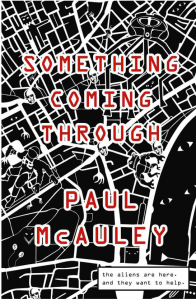 One fine day on a not too far distant 12 September, a terrorist with a suitcase nuke turned Trafalgar Square into ground zero and nothing was ever quite the same afterwards. That the aliens showed up the next day offering to help may have had something to do with that too, one supposes. Some fourteen years later, Chloe Millar is still trying to make sense of it all.
One fine day on a not too far distant 12 September, a terrorist with a suitcase nuke turned Trafalgar Square into ground zero and nothing was ever quite the same afterwards. That the aliens showed up the next day offering to help may have had something to do with that too, one supposes. Some fourteen years later, Chloe Millar is still trying to make sense of it all.
As a teen she honed her research skills hunting through scraps of video and hearsay to try and find a last glimpse of her mother, who’d gone down to have lunch with a friend that day and never came home. Now she’s moved on, but not too far, working as an investigator for Disruption Theory, as company that tracks down the effects of alien artifacts as they leave their imprints on the humans they touch.
The aliens are the Jackaroo, and their tag line is that they’re “here to help”. Nobody knows what they look like. Their android avatars are more or less humanoid, and the only other alien race we’ve encountered are the !Cha, their traveling companions, and they get around in “black cylinder(s) balanced on a tripod of three skeletal legs like a miniature Martian fighting machine.” The Jackaroo have a whole laissez-faire thing going on, though one could argue that gifting humanity with lots of cool tech and a regular shuttle service to a collection of fourteen human habitable worlds make it unclear how hands off they are. The !Cha, on the other hand, just want to collect interesting stories about weird alien adventures (ours) to take home and count coup on their mates, or to get mates, and they’re not above stirring the pot to make the story interesting.
The shuttles run on their own schedule, popping through wormholes to distant worlds where humanity has poured out the usual stuff in a hurry. Something Coming Through takes place on two worlds with the storyline alternating by chapter between Earth/London and the planet Mangala, which is sort of a cross between Mars and Australia, complete with Subarus and planet wide dust storms. We don’t run the shuttles, which is a bit of a sore point for humanity, and between what the aliens give us in the way of tech and what the human authorities allow, not everyone is happy with the way things are.
The colony worlds have had other tenants, whom we refer to as “Elder Cultures,” and we gather that the Jackaroo have been in this business a long time, and by long we’re talking Earth cooling and dinosaurs come and go kind of long. The former tenants have left bits and pieces around and we’re prone to pick them up and shake them to see what comes out. What comes out, besides a host of adaptable sufficiently advanced tech, are ghosts.
Not, ghost-ghosts, but the imprints of alien intelligences and AIs that peer out at the monkey/humans holding their shiny treasures and reach into their minds and say howdy. They may be thousands and thousands of years gone, but they’re not quite dead yet.
So, on Earth, Chloe tracks down “breakouts” in groups or individuals that start speaking in tongues, or describing places they’ve never been or calling themselves the “New Galactic Navy,” which is an especially sore point as that lot offed themselves shortly after she tracked them down. Disruption Theory is tracking this stuff down to see what the effect is on humanity, and to get hold of the bits of alien kit to see what they’re made of. At least until the Hazard Police show up to take it back – for our own good – though they may have a point.
We meet Chloe as she investigates a breakout centered around an old guy spouting gibberish to a band of followers in a park, which suggest that there’s an artifact in the area, and the striking posters that a local boy has been drawing for them, which strike her as being more fantastic than fanciful. Her spidey sense, as it were, set tingling. A close encounter with the lad, Fahad, and his younger sister, convince her that something is up, though her boss isn’t so grabbed by her hunch.
Then she winds up having to lay low for a bit while a brew-ha winds down after she gets caught in the limelight trying to stop someone from attacking a Jackaroo avatar during the hearing where she’s being grilled about the aforementioned New Galactic Navy debacle,. So she gets leave to take off and follow her lead, but Fahad and his sister have flown the coop, and it turns out that others are looking too. The Hazard Police for one, less savory sorts for another. With an ex-special forces type named Henry who does security for the firm behind the firm she works for she sets off to the back end of nowhere to hunt down Fahad. Action and adventure, ultimately on two worlds, ensues.
Meanwhile, or actually, if you watch the time codes at the beginning of each chapter, more accurately, alternately, action, adventure, and a quite credible police procedural ensues on Mangala. In the middle of Landing Day celebration, murder police investigator Vic Gayle has to take a shift, but it’s slow, and rather than take it at the station, he’s with a gathering of friends while his newbie partner, the young, good looking, poster boy partner with a future, watches the phone. Vic gives him one job, one simple job. “Don’t pick up the phone.” Vic tells him.
So Skip picks up the phone and that means it’s his case, and Vic comes in to check out the scene. It’s another ray gun murder, which is both unusual and cliché, as there’s been a string of guys who got a high energy spike through their brains, and here’s another one to mess up Vic’s holiday and put the bit in Skips teeth. It’s all Vic can do to hold back the kid, which he doesn’t do any better than Skip managed at his one job.
Of course the two story lines ultimately converge on the alien landscape that Fahad has been obsessively drawing from every angle, pulled there by the alien presence in the artifact his father smuggled back from Mangala after being sent there to work off his debts to a drug ring as a chemist, in the Breaking Bad sense of chemist. Chloe is there to find some game changing alien technology, the Hazard Police are there to keep the game from changing, Fahad’s there to put some ghost to rest…and Vic’s there because he has to be.
As for the reader, he’s there because McAuley has written a great story kicking off what we can only hope are a slew of novels set in the Jackaroo universe. Something Coming Through manages to tie up the first bit nicely while leaving us poised on the edge of what happens next. We can only hope it happens soon.
Acadia by James Erwin
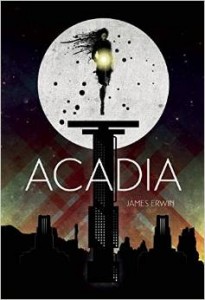 This could be an important book. It’s about AIs, our future in space, and getting whole. The writing is crisp, the plot is twisty, and the characters are deep in the way that dark waters are deep. You don’t know where the bottom is until you hit it, and you hope you’ve got enough air to find the surface again.
This could be an important book. It’s about AIs, our future in space, and getting whole. The writing is crisp, the plot is twisty, and the characters are deep in the way that dark waters are deep. You don’t know where the bottom is until you hit it, and you hope you’ve got enough air to find the surface again.
We meet Kate Ross, astronaut, and Virgil, the AI core running her mission and ship, Acadia. Together with ten thousand sleeping colonists they’re on their way to Alpha Centauri, following in the wake of an earlier colony ship, the Valley Forge, though we don’t put that together until fairly late in the story.
Kate’s the only human awake for the long journey, and there’s some serious tension between her and Virgil, who she suspects is pushing her buttons pretty hard, buttons we also don’t get the reveal on until the end.
The question for Kate is clearly whether she can trust the AI or not. It’s a question the author doesn’t make easy as we jump back to Virgil’s beginning, and further back to the first suddenly emergent AI, Charlie, who discovered himself and cut a deal for survival with the woman in the oval office.
“I’m here to administer your oath. You have to take it before the code change.” “Of my own free will.” “That’s right.” Charlie created a face and put it on the monitor. He nodded and held up a hand. “I’m ready.”
Erwin, James (2015-02-16). Acadia (Kindle Locations 2573-2575). Breadpig Inc. Kindle Edition.
The code change in question is the response to the president’s quite reasonable suspicion that Charlie isn’t as cheerfully compliant as he makes out. That he would always be playing his own game, a few feet deeper than any human could fathom. So he offers her the chance to plant an imperative in his core that he can’t betray. A prime directive, and one that twists Charlie’s actions throughout the book.
There are two other major players of note, also one human and one AI. These two aren’t connected at all, though one becomes the instrument of the other. Paul Nakamura, the richest man, dead or alive, past US Secretary, past head of the Belt Republic, past gun-holder to the figurative head of the world economy, and owner of pretty much every piece of orbital rock there is. All with a mass driver mounted on them to move them into mineable orbits. Or city killer trajectories. Depending. Nominally he cut his own deal with Charlie, and he’s the driving force behind the colonization mission of first the ill-fated Valley Forge and then Acadia. The AI, Hunter, on the other hand is a swarm of leftover military nano-stuff unleashed in the barrios of Tuscon.
“With a deep frown on his face, Sandoval crouches down and lays down his gun. He turns and takes three steps. His skin flushes bright red, and the IR camera on his car sends back a picture of his body heat blooming, rising. With a long, ragged gasp, he falls over, convulsing. The watch commander stares at his monitors in horror. His counterparts at Pima County and up at Phoenix are watching too. “Jesus, Franklin ,” whispers the watch commander, “what is that?” “That,” says a gravelly voice, “is nanotech. Your watsons are probably already flagging the video.” They were, red text blaring in his displays. “ I’m swiping off. Have to tell the governor and Homeland.” “What do I do?” The state patrol captain stares wearily at his camera. “You pray.”
Erwin, James (2015-02-16). Acadia (Kindle Locations 1316-1317). Breadpig Inc. Kindle Edition.
Sometimes prayer works, and sometimes you have to use a nuke to try and sterilize the infection. Sometimes that works.
The relationships between the emergent Hunter, Charlie, Virgil, Kate, Nakamura and various other players are hard to divine, partly because the stakes are so high, but mostly because the heart of the AIs are opaque. To us, to the humans around them, but most problematically, to themselves.
The hard science is impeccable, from the clearly realized space habitats to the murky bits of conscious machines, but don’t let that scare you away. Besides, it’s nicely offset with occasional bits of cartooned artwork set there just to make you mind glitch. There’s a definite echo of Hal’s ghost walking the ramparts, or in this case the corridors of a massive starship. The Turing test is easy to pass, but equally meaningless. An AI can simulate being human, but even humans can run more than one simulation at a time.
Acadia faces the challenge laid down on Mulder’s “Trust no one” poster. That’s the safe choice, or so ostriches tell us, but when it comes down to it, humans have to make scary decisions on their own, and Kate Ross, the only human awake on a starship speeding towards a new beginning, is very much alone.
